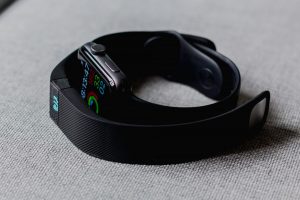Designing the next generation of wearable eHealth devices
By Simon Vogt, CCO, P2i

Simon Vogt CCO
Smart accessories including wearables devices, have continued to show strong growth through the Covid-19 pandemic, driven at least in part by the ‘lipstick effect’, the theory that when facing an economic crisis, consumers will be more willing to buy less costly luxury goods. In line with this, a recent study by research firm, Canalys, expects shipments of smartphone accessories, namely wearable bands and true wireless (TWS) devices, to exceed 200 million units and 350 million units respectively in 2021.
Growth in the wearables sector is also being driven by people new to such devices and also by miniaturisation that enables manufacturers to embed smaller and smarter sensors into garments so they can track sleep or medical conditions while remaining almost invisible to their users.
Changes in consumer habits are also driving the growth. Much of the population are now adapting to new Covid-driven routines and consumers are now more fitness and health conscious than ever and are turning to wearable eHealth technology. A fitness tool backed by the NHS in the UK has been adopted by hundreds of thousands of people seeking to get in shape during lockdown, for example.
eHealth technology is also relatively affordable. People are engaged with the idea of getting technology that is fashionable and new, yet a fraction of the cost of a new iPhone. If they monitor their own health and catch symptoms and illnesses, they can help protect themselves and keep healthcare costs down.
Many consumers also see consenting to some level of data sharing as an acceptable consequence of buying a wearable product. In this way, they are effectively contributing to broader societal advances. Health researchers in a joint cross-border European project, for example, analysed data from smartphone and wearable devices to assess behaviour during the pandemic. Globally, experts are examining how to use mobile and wearable health technologies to fight against Covid-19 and future pandemics, as in the report by The Task Force on mHealth Technology.
Accommodating different form factors
 Consumers are less willing to compromise on style when it comes to wearable eHealth technology, demanding smartwatches become more fashion-focused than the clunky designs of past generations. There has also been a widening in the number of health categories to encompass not only fitness, but also heart health, femhealth and even mental health.
Consumers are less willing to compromise on style when it comes to wearable eHealth technology, demanding smartwatches become more fashion-focused than the clunky designs of past generations. There has also been a widening in the number of health categories to encompass not only fitness, but also heart health, femhealth and even mental health.
The various form factors include rigid, flexible, stretchable, thin and large-area. Generally, current wearables are using customised sensors because of the small volumes. Despite the variety of shapes and sizes, sensors are still mainly developed to a standard design, but they may need to evolve in the future to fit the many different form factors of the eHealth devices.
For this, miniaturisation will be key, whether or not there is standardisation of sensor design. Additionally, silicon photonic integrated chip sets offer the promise to reduce battery usage to extend the longevity of wearables by prolonging battery life and improve user experience. All of these elements are sensitive and require a flexible approach to liquid protection.
Why liquid protection is needed
Wearable devices are often worn 24 hours a day and only taken off when charging is required. They are frequently worn during exercise, increasing risk of damage from sweat and are also worn during swimming, leading to further risk of water damage through immersion. Shower steam is a further risk factor and there is the risk of damage from rain or humidity, for instance, when devices are worn outdoors.
Designs need to be robust enough to avoid excessive cleaning damage caused by users regularly cleaning the touch surfaces of their devices, a growing issue in the time of Covid-19.
What solutions are available?
 There are three broad options: mechanical sealing, individual component liquid protection, or coatings. Traditional liquid protection methods like mechanicals seals or conformal coatings are often unwieldy or unreliable and come with many kinds of problems, such as being prone to cracking, delaminating and degrading. Mechanical seals are rigid and inflexible when it comes to protecting miniaturised components
There are three broad options: mechanical sealing, individual component liquid protection, or coatings. Traditional liquid protection methods like mechanicals seals or conformal coatings are often unwieldy or unreliable and come with many kinds of problems, such as being prone to cracking, delaminating and degrading. Mechanical seals are rigid and inflexible when it comes to protecting miniaturised components
In contrast, the latest nano coatings are far more flexible and reliable and are ideal for providing effective water protection to wearable devices. These nano coatings offer robust protection plus protection to internal electronics against corrosion or damage from cleaning agents such as IPA.
The importance of repairability
It is also important that eHealth devices and the solutions that protect them from liquid damage are repairable. This is particularly key in the manufacturing process where especially if a business is producing small volumes, it will want to be both environmentally and cost-efficient.
There are also consumer pressures from the right to repair movement to factor in. eHealth devices are still sometimes seen as a toy or fashion accessory but as they transition into auxiliary medical tools, the need for repairability will become more urgent. Nano coatings can continue delivering liquid protection and do not degrade over time, so will last the whole product lifetime.
That’s key in this context. Nano coatings are not compromised by other types of damage. So, even if a product does need to be reworked or repaired, the coating will remain effective. They are a solution therefore that can help protect eHealth devices through their normal lifetime and help extend that lifetime further.
Simon Vogt, Chief Commercial Officer, P2i
Simon has over 20 years telecommunications experience at Motorola, Nokia, Siemens Networks and NewNet Communication Technologies, managing the proposals and pricing operations. Having joined P2i in July 2017 as Group Head of Sales Operations, his role has since expanded to take on responsibility for Sales, Business Development and Pricing. Simon earned a Master’s Degree in Information Technology and has a multinational background, having lived and worked in the UK, Dubai and the US.












